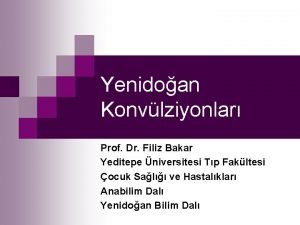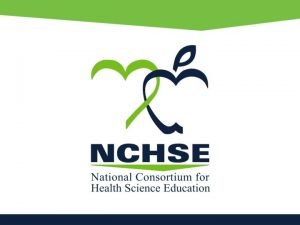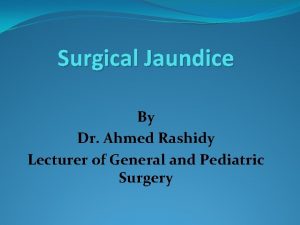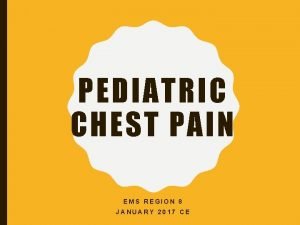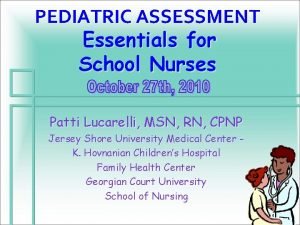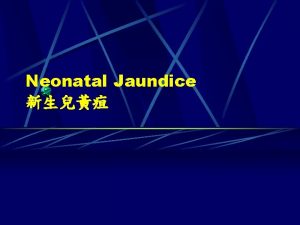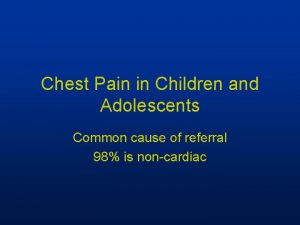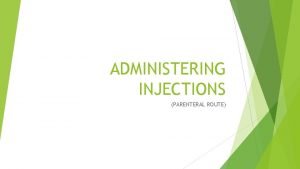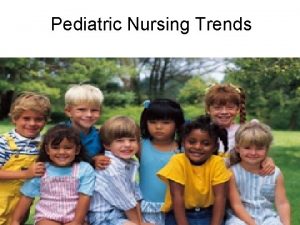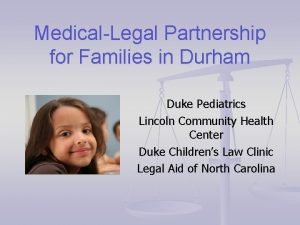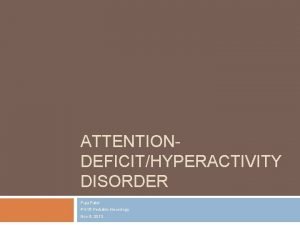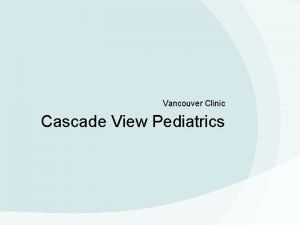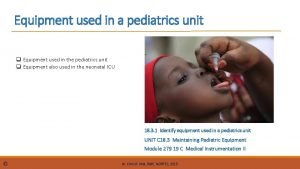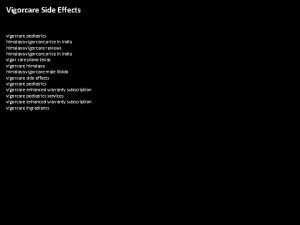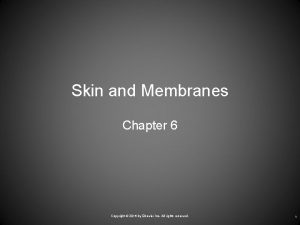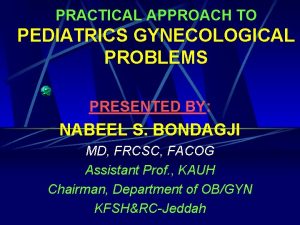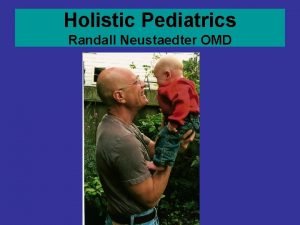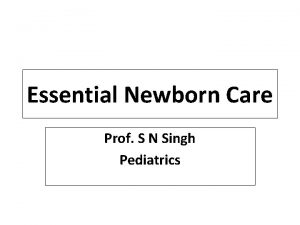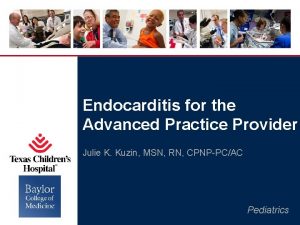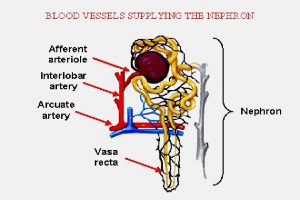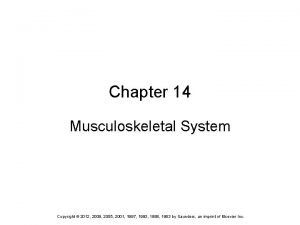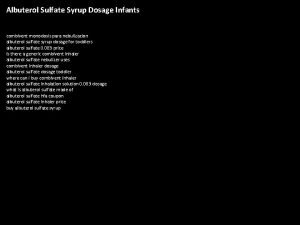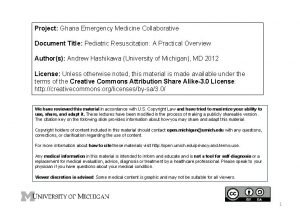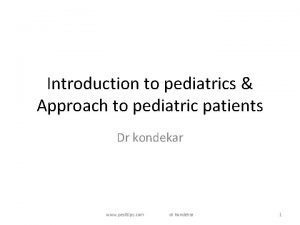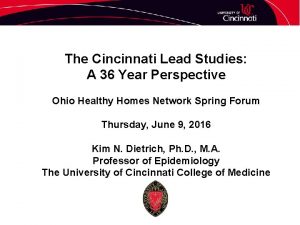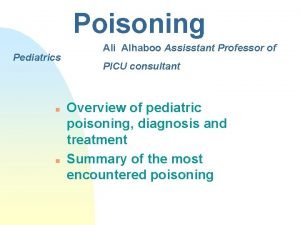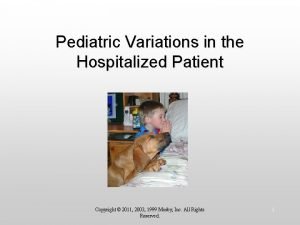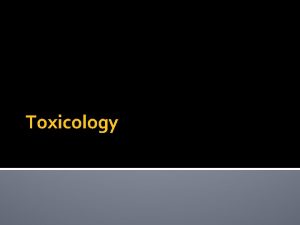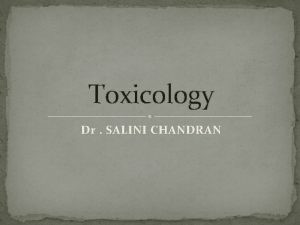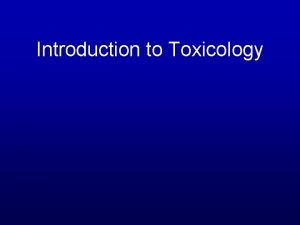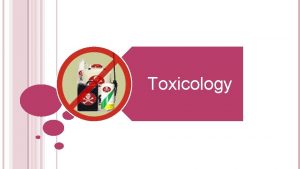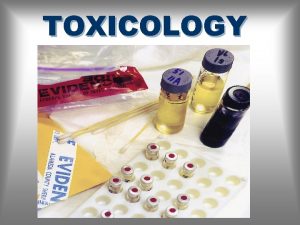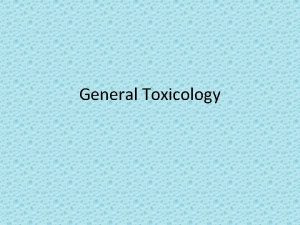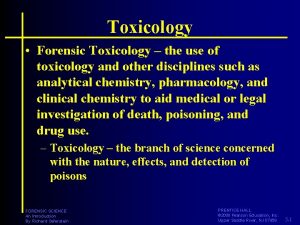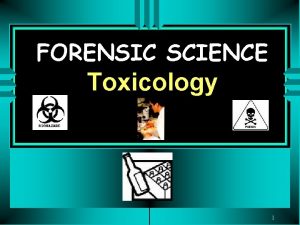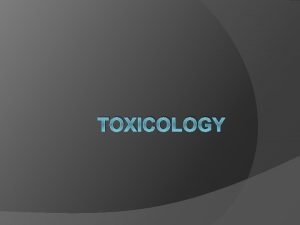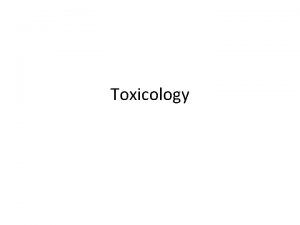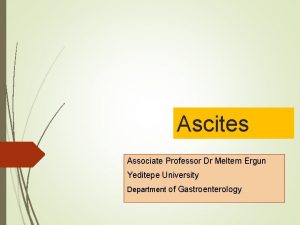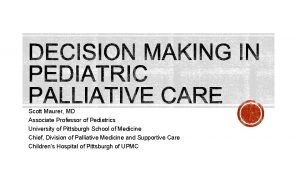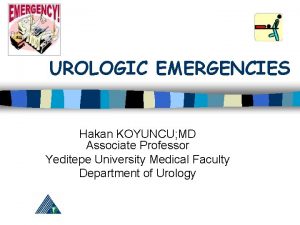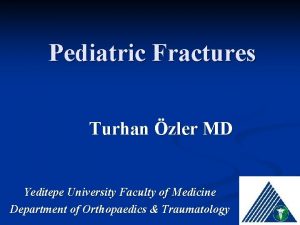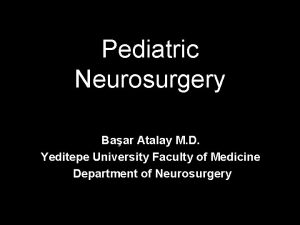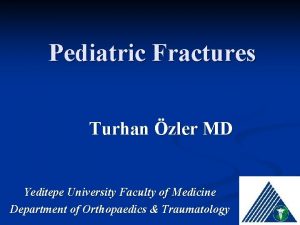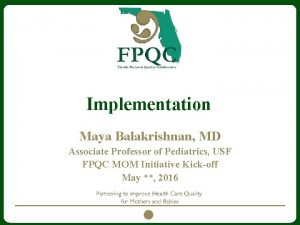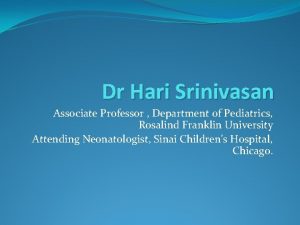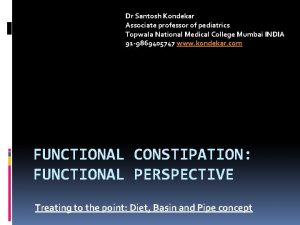Pediatric Toxicology Associate Professor of Pediatrics Yeditepe University








































- Slides: 40

Pediatric Toxicology Associate Professor of Pediatrics Yeditepe University Faculty of Medicine Child Health and Pediatrics

Objectives • Explain the general management principles for ingestions and toxic exposures. • Identify methods used to minimize drug absorption. • Describe the specific therapies, including antidotes, for common poisonings. • Identify the available resources for consultation for treating the child with poisoning or toxin exposure.

• A 2 year old boy presents to the emergency department (ED) with his frantic parents, who had found him unresponsive in the bathroom with pills and empty bottles "scattered all over the floor. " • The child is normally healthy but now is lethargic with no response to stimuli and shallow and slow respirations but no cyanosis. • Vital signs include a respiratory rate of 8/min, a pulse of 70/min, blood pressure of 80/40 mm Hg, and temperature of 35. 6°C (96°F). • Focused physical examination reveals pupils that are 4 mm each and reactive to light, a supple neck, clear lungs, nontender abdomen with no masses, normoactive bowel sounds, extremities with good pulses, and no focal neurologic deficits. There is no evidence of trauma.

Questions • 1. What are the initial management priorities in this child? • 2. What antidotes should be administered? • 3. What further history is important in this case?

General Evaluation and Management of Ingestions • Poisoning continues to be a preventable cause of morbidity and mortality in children and adoles cents. • It is imperative that pediatricians, family physicians, emergency physicians, and pediatric emergency physicians be familiar with the general approach to the poisoned child and the latest treatment methods available. • Poisoning can occur from ingestion, dermal absorption, or inhalation of toxins, with ingestions being the most common exposure. • Although many pediatric patients present with a history of a specific toxic exposure, others present with unexplained signs or symptoms and no history of poisoning.

Epidemiology • Since the early 1960 s, there has been a 95% decrease in the number of pediatric poisoning deaths. • Child resistant product packaging, increased public awareness of potential household toxins, a national toll free poison control telephone number, and advances in emergency and critical care medicine have all helped to reduce morbidity and mortality. • More than 60% of calls received by regional poison centers in the United States involve children younger than 17 years. • Most exposures in this group are unintentional and result in minimal toxic effects. • The highest morbidity and mortality rates occur in adolescent and adult patients, but younger children also can be severely affected.

Clinical Features • Toxins cause damage to the body by a variety of mechanisms. • Poisons can act at a cellular level (eg, cyanide) or affect a specific organ system, such as the brain (eg, opioids, hypnotic sedatives, and major tranquilizers), autonomic nervous system (eg, organophosphates), lung (eg, hydrocarbons and paraquat), gastrointestinal tract (eg, caustics and corrosives), liver (eg, acetaminophen [paracetamol] and cyclopeptide mushrooms), or blood (eg, heavy metals). • The range of pathologic processes that can be caused by noxious agents is great.

• If possible, the specific poison should be identified. • A detailed history should be obtained from the patient, family members, friends, rescuers, or bystanders. • It is important to identify the ingested substance or substances, the amount and time of ingestion, presence of allergies or underlying diseases, and any first aid treatment that has already been administered. • Family, friends, or police might need to search the home for the toxin. • Examine clothing and personal effects for ingestants and Medic. Alert identification. • In addition, a detailed environmental and social history should be obtained.

• A brief physical examination should be performed, concentrating on neurologic and cardiopulmonary status. • Distinct toxic syndromes should be identified if present.

• The physical examination and vital signs can help identify particular groups of toxins. • Hypertension suggests a sympathomimetic overdose, such as cocaine, amphetamines, or phencyclidine; hypotension suggests beta blocker, calcium channel blocker (CCB), digitalis, or antihypertensive agents, such as clonidine. • Tachycardia can be present in ingestions of the same sympathomimetic drugs that cause hypertension, as well as methylxanthines such as theophylline; bradycardia can be associated with digitalis, beta blockers, calcium channel antagonists, or clonidine.

• Hypothermia is associated with hypoglycemia, ethanol, and opioids. • Fever can be produced by salicylates, anticholinergics, or withdrawal from alcohol or narcotics. • Respirations are depressed with sedative hypnotics and opioids but increased in cases of pulmonary aspiration (hydrocarbons), pulmonary edema (narcotics and salicylates), metabolic acidosis (ethylene glycol, methanol, and salicylates), chemical pneumonitis, and smoke inhalation. • Pupil size, skin signs, and specific odors also can help identify the class of ingested agent.

Cholinergic Common Toxidromes Examples: organo phosphates, carbamates, pilocarpine DUMBELLS Diarrhea, diaphoresis Urination Miosis Bradycardia, broncho secretions Emesis Lacrimation Lethargic Salivation Nicotinic M-Mydriasis T-Tachycardia W-Weakness T-Tremors F-Fasciculations S-Seizures S-Somnolent Anticholinergic Examples: antihistamines, cyclic antidepressants, atropine, benztropine, phenothiazines, scopolamine Hyperthermia {HOT as a hare) Flushed (RED as a beet) Dry skin (DRY as a bone) Dilated pupils (BLIND as a bat) Delirium, hallucinations (MAD as a hatter) Tachycardia Urinary urgency and retention Sympathomimetic Examples: cocaine, amphetamines, ephedrine, phencyclidine, pseudoephedrine Mydriasis Tachycardia Hypertension Hyperthermia Seizures Opioid Examples: heroin, morphine, codeine, methadone, fentanyl, oxycodone, hydrocodone Miosis Bradycardia Hypotension Hypoventilation Coma Withdrawal Diarrhea Mydriasis Goose flesh Tachycardia Lacrimation Hypertension Yawning Cramps Hallucinations Seizures (with alcohol and benzodiazepine withdrawal)

• With an assessment of mental status based on the Glasgow Coma Scale or AVPU (alert, responds to verbal stimuli, responds to painful stimuli, unresponsive) system, the level of consciousness should be quantified. • Always consider other causes of altered mental status, such as infection, metabolic imbalance, or trauma, and rule these out through appropriate diagnostic evaluation.

Diagnosing Toxicity From Vital Signs Bradycardia (PACED) • Propranolol (p-blockers), poppies (opiates), propoxyphene, physostigmine • Anticholinesterase drugs, antiarrhythmics • Clonidine, calcium channel blockers • Ethanol or other alcohols • Digoxin, digitalis

Tachycardia (FAST) • Free base or other forms of cocaine, freon • Anticholinergics, antihistamines, antipsychotics, amphetamines, alcohol withdrawal • Sympathomimetics (cocaine, caffeine, amphetamines, phencyclidine), solvent abuse, strychnine • Theophylline, tricyclic antidepressants, thyroid hormones

Hypothermia (COOLS) • Carbon monoxide • Opioids • Oral hypoglycemics, insulin • Liquor (alcohols) • Sedative - hypnotics

Hyperthermia (NASA) • Neuroleptic malignant syndrome, nicotine • Antihistamines, alcohol withdrawal • Salicylates, sympathomimetics, serotonin syndrome • Anticholinergics, antidepressants, antipsychotics

Hypotension (CRASH) • Clonidine, calcium channel blockers • Rodenticides (containing arsenic and cyanide) • Antidepressants, aminophylline, antihypertensives • Sedative - hypnotics • Heroin or other opiates

Hypertension (CT SCAN) • Cocaine • Thyroid supplements • Sympathomimetics • Caffeine • Anticholinergics, amphetamines • Nicotine

Rapid respiration (PANT) • Phencyclidine, paraquat, pneumonitis (chemical), • Phosgene • Acetylsalicylic acid and other salicylates • Noncardiogenic pulmonary edema, nerve agents • Toxin-induced metabolic acidosis

Slow respiration (SLOW) • Sedative-hypnotics (barbiturates, benzodiazepines) • Liquor (alcohols) • Opioids • Weed (marijuana)

Diagnostic Studies • Patients with central nervous system (CNS) or cardiopulmonary compromise require cardiac monitoring. If cardiac rhythm disturbances are present or the patient is known to have ingested a cardiotoxic poison (eg, tricyclic antidepressant [TCA], CCB, or digitalis), a 12 lead electrocardiogram (ECG) should be performed and the blood pressure closely monitored. • If the level of consciousness is altered or respiratory problems are present, a chest radiograph should be performed. Aspiration pneumonitis, noncardiogenic pulmonary edema, or acute lung injury can be present. Certain medications, such as iron, other heavy metals, and illicit drug packets, might be seen on abdominal radiographs.

• Serum electrolyte and arterial blood gas determinations can provide valuable information about possible toxic or metabolic processes, if the arterial blood gas analysis reveals a metabolic acidosis, calculation of the anion gap (Na+ — [Cl" + C 02]) can provide valuable information. • A normal anion gap of 8 to 12 m. Eq/L can result from loss of bicarbonate (diarrhea) or the addition of chloride. • An increased anion gap greater than 12 m. Eq/L is suggestive of the presence of organically active acids, which can occur with several toxins (salicylates, iron, isoniazid. methanol, ethylene glycol, toluene, and cyanide) or metabolic problems (diabetic ketoacidosis and lactic acidosis). • An osmolar gap (measured osmoles minus calculated osmoles) of greater than 10 will be present in patients who have ingested ethanol, methanol, isopropanol, or ethylene glycol. • Calculated osmoles are derived from the formula 2 x Na+ + glucose/18 + blood urea nitrogen (BUN)/2. 8 + ethanol/4. 6.

• Toxicology screening of blood and urine rarely contributes to the short term treatment. • There might be academic or forensic indications for performing these studies, in which case they can be performed on a routine turnaround time. • A negative toxicology screen result does not rule out the possibility of a toxin. • If a particular drug or class of drugs is suspected, this should be communicated to the laboratory. • Serum levels of specific drugs might be available to guide management or predict prognosis. • Examples include acetaminophen (paracetamol), acetyl salicylic acid, digoxin, ethanol, ethylene glycol, methanol, iron, lead, lithium, and theophylline.

Agents That Affect Pupil Size Miosis (COPS) • Cholinergics, clonidine, carbamates • Opiates, organophosphates • Phenothiazines (antipsychotics), pilocarpine, • pontine hemorrhage • Sedative hypnotics Mydriasis (SAW) • Sympathomimetics • Anticholinergics • Withdrawal

Management is based on the following general principles: • Pediatric assessment triangle (PAT) • ABCs (airway, breathing, circulation) • Provision of supportive care • Prevention or reduction of absorption • Enhancement of excretion • Administration of antidotes

Pediatric Assessment Triangle

Primary Assessment • In the primary assessment, the physician must determine rapidly whether a child is in respiratory failure or shock.

COMA (LETHARGIC) • L Lithium, lead • E Ethanol, ethylene glychol, ethchlorvynol • T Tricyclic antidepressants, thallium, toluene • H Hypoglysemics, heroin, hepatic ancephalopathy, heavy metals, hydrogen sulfide • A Arsenic, antidepressants, anticonvulsants, antipsycotics, antihistamines • R Rohipnol (sedatif hipnotikler), risperidone • G Gamma hydroxybutirate • I Isoniazide, insulin • C Carbon monoxide, cyanide, clonidine

Convulsants • • • Organofosfatlar, oral hipoglisemikler Trisiklik antidepresanlar Izoniyazid, insülin Sempatomimetikler, striknin, salisatlar Kamfor, kokain, karbon monoksit, siyanid, klorlu hidrokarbonlar Amfetaminler, antikolinerjikler, Metilksantinler (teofilin, kafein), metanol Fensiklidin, propranolol Benzodiazepinden uzaklaşma, bitkiler (su baldıranı, nikotin), bupropiyon, gama hidroksibütrat Etanolden uzaklaşma, etilen glikol Lityum, lidokain (lignokain) kurşun, lindan

• The patient, not the poison, should be treated. • Attention to the standard ABCs of resuscitation is always the first priority. • The PAT should be performed: evaluate the appearance, work of breathing, and circulation to the skin. • Derangements should be treated with oxygen, support of ventilation, specific therapy, and fluid resuscitation as indicated. • The PAT is followed by the ABCDEs (airway, breathing, circulation, disability, exposure).

• The glucose level should be assessed using a bedside glucose oxidase reagent strip and glucose administered (0. 5 1 g/kg as 2 4 m. L/kgof 25% dextrose in water or, for older children, as 1 2 m. L/kg of 50% dextrose in water) by intravenous (IV) push if indicated. • Naloxone can be used for any child in a coma at a dose of 0. 1 mg/kg; it is also acceptable to administer 2 mg for a child older than 5 years. • If an adolescent is opioid habituated, small incremental doses are recommended.

Prevention or Reduction of Absorption • Gastric lavage is indicated only: if the patient arrives in the ED less than 1 hour after ingestion of a potentially life-threatening toxin, if the patient has ingested massive amounts of the toxin, for those substances that do not bind to charcoal.

Agents Visible on Abdominal Radiographs (COINS) • Chloral hydrate, cocaine packets, calcium • Opium packets • Iron, other heavy metals, such as lead, arsenic, mercury • Neuroleptic agents • Sustained-released or enteric coated agents

Substances Not Adsorbable by Activated Charcoal (PHAILS) • Pesticides, potassium • Hydrocarbons • Acids, alkali, alcohols • Iron, insecticides • Lithium • Solvents

Agents Responsive to Multiple Doses of Activated Charcoal (ABCD) • Antimalarials (quinine), aminophylline (theophylline) • Barbiturates (phenobarbital) • Carbamazepine • Dapsone

Toxins Accessible to Hemodialysis (UNSTABLE) • Uremia • No response to conventional therapy • Salicylates • Theophylline • Alcohols (isopropanol, methanol) • Boric acid, barbiturates (phenobarbital) • Lithium • Ethylene glycol

Enhanced Elimination by Charcoal Hemoperfusion • Theophylline • Barbiturates • Carbamazepine • Paraquat • Glutethimide

Antidotes and Their Indications Antidote Indication (agent) N acetylcysteine Acetaminophen (paracetamol) Ethanol and fomepizole (4 MP) Methanol and ethylene glycol Oxygen and hyperbarics Carbon monoxide Naloxone and nalmefene Opioids Physostigmine Atropine and pralidoxime (2 PAM) Methylene blue Nitrites and hydroxycobalamin Deferoxamine Anticholinergics Organophosphates Methemoglobinemia Cyanide Iron Dimercaprol (BAL) Lead, arsenic Succimer (DMSA) Lead, mercury Ca. EDTA Lead

Antidotes and Their Indications Antidote Fab fragments Glucagon Sodium bicarbonate Calcium, insulin, and dextrose Dextrose, glucagons, and octreotide Lipid emulsion therapy Indication (agent) Digoxin, crotalids, colchicine β blockers, calcium channel blockers Tricyclic antidepressants Calcium channel antagonists Oral hypoglycemic agents Local anesthetics, antipsychotics
 Promotion from associate professor to professor
Promotion from associate professor to professor Yeditepe üniversitesi hastanesi
Yeditepe üniversitesi hastanesi Coadsysexam yeditepe
Coadsysexam yeditepe Coadsys exam
Coadsys exam Pulse grading 2+
Pulse grading 2+ Vital signs normal range
Vital signs normal range Courvoisier law
Courvoisier law Clove hitch knot restraint
Clove hitch knot restraint Volutrol
Volutrol Chest pain in pediatrics
Chest pain in pediatrics Deep tendon reflex
Deep tendon reflex Child pain scale
Child pain scale Differential diagnosis of jaundice in pediatrics
Differential diagnosis of jaundice in pediatrics What is the modern concept of pediatrics
What is the modern concept of pediatrics Modern concept in child health care pdf
Modern concept in child health care pdf Nbme shelf exam percentiles 2019
Nbme shelf exam percentiles 2019 Chest pain in pediatrics
Chest pain in pediatrics Bristol pediatric
Bristol pediatric Im injection sites and volumes pediatrics
Im injection sites and volumes pediatrics Trends in pediatric nursing definition
Trends in pediatric nursing definition Nec diagnosis
Nec diagnosis Duke pediatrics durham nc
Duke pediatrics durham nc Holzer pediatrics
Holzer pediatrics Vancouver clinic pediatrics
Vancouver clinic pediatrics Equipment used in pediatrics
Equipment used in pediatrics Lsuhsc pediatrics
Lsuhsc pediatrics Himalaya vigorcare price
Himalaya vigorcare price Nelson pediatrics
Nelson pediatrics Practical approach pediatrics
Practical approach pediatrics Randall neustaedter
Randall neustaedter Fv pediatrics
Fv pediatrics Warm chain in pediatrics
Warm chain in pediatrics Disease xxx
Disease xxx Nelson pediatria
Nelson pediatria Nelson pediatrics
Nelson pediatrics Combivent dosage for pediatrics
Combivent dosage for pediatrics Vitals chart
Vitals chart Introduction of pediatrics
Introduction of pediatrics Tlc pediatrics flint
Tlc pediatrics flint Nn pediatrics
Nn pediatrics Mummy restraint in pediatrics
Mummy restraint in pediatrics

